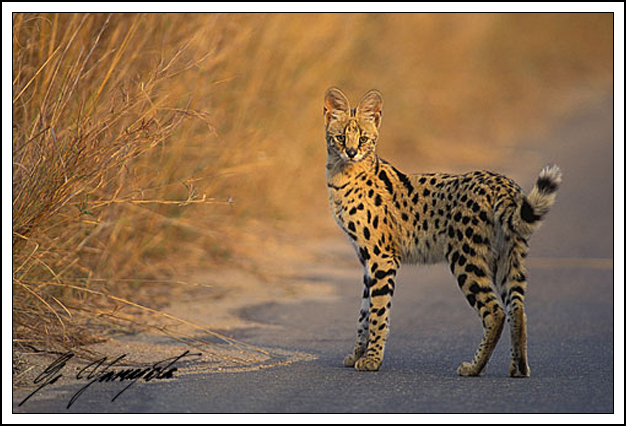Last night, after dinner, we went on a game watch. I can’t say that looking for game at night is my favorite thing. It’s spooky. We had a red light spotlight that our Samburu guide, Philip, shined into the brush and along the banks of a couple of waterholes. It picks up this pink or red shine from the eyes of animals like hyenas. I don’t particularly like seeing hyenas during the day but at night they just look like devils, loping along with their crippled hips and ghoulish laugh.
The Swahili name for hyena is fisi and the natives have an odd relationship with them. They despise them yet for the most part they won’t kill them. Partly because many of the tribes, including the Maasai and Samburu, leave their dead out in the bush for hyenas to consume and so they fear that if they kill a hyena they might be killing a relative’s soul.
There is a story Calvin tells about running into a Maasai, in Nairobi, who had worked for him at his safari camp in the Mara. The man’s face was horribly disfigured. Calvin asked him what had happened.
“Simba,” said the Maasai. A lion had attacked him.
Later Calvin heard that the warrior had really been attacked at night by a hyena who tried to chew off his face while he was sleeping.
“You’ll see lots of Maasai with scars from hyena attacks,” Calvin said, “but they’ll never admit it. They always say it was a simba. It’s too embarrassing to admit you’ve been attacked by a fisi. Saying it was a lion makes you seem more courageous.”
Well, we saw lots of fisi moving around the water hole and they made me shutter with disgust.
We backed away from the water hole and the Land Cruiser got stuck in some soft sand and for a moment I thought we were going to have to get out and push, while the fisi watched, but the driver rocked the vehicle a few times and eventually we got out of our hole.
We drove through the thick woodland, the red light washing through the branches of the trees as we looked for leopard when Philip said, “Mondo!”
I had no idea what mondo was. And although I scanned the trees and bushes, I didn’t see anything. Until Calvin pointed to what looked like a large house cat with big ears—a serval, one of the Small Five. That now meant we’d seen African porcupine, rock hyrax, and serval. Only mongoose and aardvark remained.
The serval didn’t stick around for long but I have to say that from what little I saw of him, he was a beautiful cat. Maybe even more so than the cheetah. It was about two feet high, maybe three feet long, with black polka dots decorating its tawny fur. The most noticeable thing about it however were its ears which were extremely long and stood up on top his head almost like bunny ears. That’s how they hunt, Calvin said. They have exceptional hearing and they listen for the sound of a rodent or frogs or birds. And even before they can see them, they pounce. Trusting their hearing to tell them exactly where their prey is situated.
Seeing the serval washed away the bad taste in my mouth left from the hyenas. And also put a cap on the evening of game watching. We started slowly back for camp, the red spotlight turned off, the bouncing beams from the headlights occasionally picking up the glint of other small animals in the bush though we seldom had time to identify them before they were off. But just before we came to the fork in the road that led back to Sarara, we passed a banded mongoose. Standing up on his hind legs along the side of the road as if he was hitchhiking. In fact, seeing this little thing standing on his hind legs, I yelled out “Meerkat!” Calvin corrected me. Although meerkats are members of the mongoose family, you won’t find any of them living in this neck of the woods (more like Botswana and South Africa).
The little guy was kind of cute. And seemed undisturbed by our presence. In fact he sort of tottled up the road towards us to have a better look. Or maybe he really did want a ride. In any case, we left him by the side of the road, intently watching us as we drove away.
To see more of Go Yamagata’s terrific Africa images, click on the link to his website.
Tags: Sarara


Recent Comments